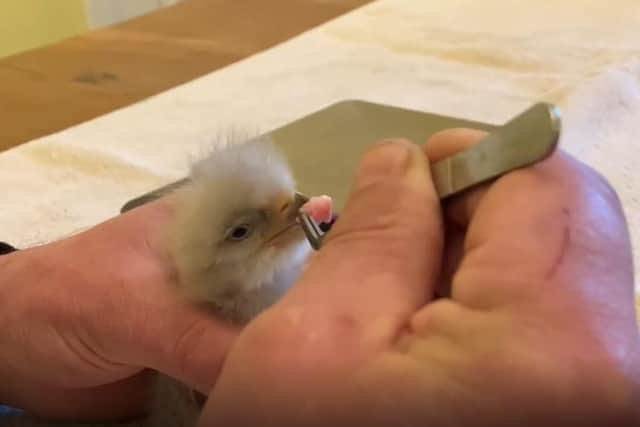Sea eagles: Watch moment rare sea eagle chick is fed for the first time after being hatched in Yorkshire
The feisty little Steller’s Sea Eagle hatched at 8:50 yesterday morning (Mar 16) at the National Centre for Birds of Prey, in Helmsley, delighting conservationists.
The species, which is native to Kamchatka Peninsula, in Far East Russia, is considered “globally threatened and vulnerable”, with only around 5000 left in the wild.
Advertisement
Hide AdAdvertisement
Hide AdCharlie Heap, director of the bird sanctuary, said his team was “living the dream” after their adult female, Inowashi, 13, produced two eggs this spring.


He said: “It’s the best thing ever. We’ve had a couple of false starts along the way, and I was forced to wait quite a long time.
“But it’s a real living the dream moment, and we're achieving ambitions to be doing things like this. It’s amazing – just perfect.”
The sea eagle is one of the largest birds of prey – weighing as much as 20lb (9kg) when fully grown and boasting a wingspan of up to 8ft (245cm).
Advertisement
Hide AdAdvertisement
Hide AdBut Charlie explained that the magnificent looking birds are in decline as their native habitat is shrinking due to oil drilling off the coast of Siberia, Russia.
He said: “They live in a range that is thousands of miles long, but its only hundreds of miles wide, so they are extraordinarily vulnerable to change and disturbance.”
“We’ve all seen the things on TV with oil spills and what have you – that could be a species extinction event for birds like this.”
The sea eagles were bred as part of a European wide programme to increase the numbers held in captivity.
Advertisement
Hide AdAdvertisement
Hide AdCharlie said: "It’s really important that every zoo breeds the species that they hold to enlarge the captive population and the captive gene pool.
“They sits there like a bank in various collections all over the place in case they’re ever needed, and this is where being part of a cooperative system is absolutely critical.
Charlie said specialists at the wildlife sanctuary had waited years to successfully breed their two adult Steller eagles named, Inowashi, 13, and Husband, 11.
He said: “I think we had the pair for eight years before we managed to successfully breed them. We’ve had a couple of false starts along the way.
Advertisement
Hide AdAdvertisement
Hide Ad“Breeding eagles is not for impatient people, and I’m an impatient person, and I was forced to wait quite a long time.
“It’s really important that they’re raised by their own parents because young eagles grow up thinking that they’re the same as whatever species raises them."
“So if you hand raise them, you get eagles thinking they are people.”
The Steller Sea Eagle is classified by the International Union for Conservation of Nature (IUCN) as on the “Red List” of globally threatened birds.
There are only around 2000 breeding pairs in the world, and the species is believed to be in overall decline.
